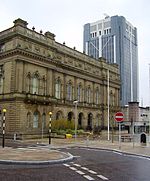Blackburn Museum and Art Gallery
Art museums and galleries in LancashireBuildings and structures in BlackburnGrade II listed buildings in LancashireHistory of Blackburn with DarwenMuseums in Lancashire ... and 3 more
Textile museums in the United KingdomTourist attractions in BlackburnUse British English from February 2023

The Blackburn Museum and Art Gallery is the local museum service for the borough of Blackburn with Darwen Borough Council. It is a museum with collections of Christian icons, Egyptian hieroglyphs, and local history, as well as those of the former Lewis Textile Museum.
Excerpt from the Wikipedia article Blackburn Museum and Art Gallery (License: CC BY-SA 3.0, Authors, Images).Blackburn Museum and Art Gallery
Exchange Street,
Geographical coordinates (GPS) Address Phone number Nearby Places Show on map
Geographical coordinates (GPS)
| Latitude | Longitude |
|---|---|
| N 53.7501 ° | E -2.4841 ° |
Address
The Making Rooms
Exchange Street 1
BB1 7JN , Four Lane Ends
England, United Kingdom
Open on Google Maps









